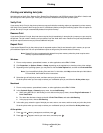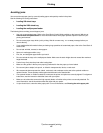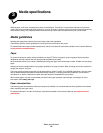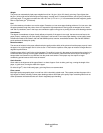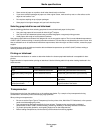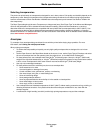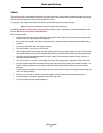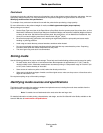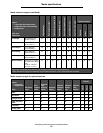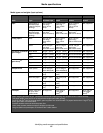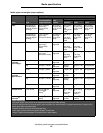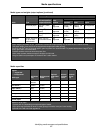
Storing paper
50
Media specifications
Selecting transparencies
The printer can print directly on transparencies designed for use in laser printers. Print quality and durability depend on the
transparency used. Always print samples on the transparencies being considered for use before buying large quantities.
Lexmark recommends Lexmark Part Number 12A8240 letter size transparency and Lexmark Part Number 12A8241 A4
size transparency.
The Paper Type setting should be set to Transparency to help prevent jams. (See “Paper Type” in the Menus and Messages
Guide on the publications CD for detailed information about this setting.) Check with the manufacturer or vendor to
determine whether the transparencies are compatible with laser printers that heat transparencies to 230°C (446°F). Use
only transparencies that are able to withstand these temperatures without melting, discoloring, offsetting, or releasing
hazardous emissions. For detailed information, see the Card Stock & Label Guide, which is available on the Lexmark Web
site at www.lexmark.com/publications.
Envelopes
Try a sample of any envelopes being considered for use with the printer before buying large quantities. For more
information, see Loading the multipurpose feeder.
When printing on envelopes:
• To achieve the best possible print quality, use only high-quality envelopes that are designed for use in laser
printers.
• Set the Paper Source in the Paper Menu based on the source in use, set the Paper Type to Envelope, and select
the correct envelope size from the operator panel, the printer driver, or from MarkVision Professional.
• For best performance, use envelopes made from 90 g/m
2
(24 lb bond) paper. Use up to 105 g/m
2
(28 lb bond)
weight for the 250-sheet standard tray or 105 g/m
2
(28 lb bond) weight for envelopes as long as the cotton content
is 25% or less. Envelopes with 100% cotton content must not exceed 90 g/m
2
(24 lb bond) weight.
• Use only new, undamaged envelopes.
• For best performance and to minimize jams, do not use envelopes that:
– Have excessive curl or twist
– Are stuck together or damaged in any way
– Contain windows, holes, perforations, cutouts, or embossing
– Use metal clasps, string ties, or metal folding bars
– Have an interlocking design
– Have postage stamps attached
– Have any exposed adhesive when the flap is in the sealed or closed position
– Have nicked edges or bent corners
– Have rough, cockle, or laid finishes
• Use envelopes that can withstand temperatures of 230°C (446°F) without sealing, excessive curling, wrinkling, or
releasing hazardous emissions. If any doubts exist about the envelopes considered for use, check with the
envelope supplier.
• A combination of high humidity (over 60%) and the high printing temperatures may seal the envelopes.



